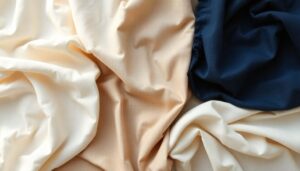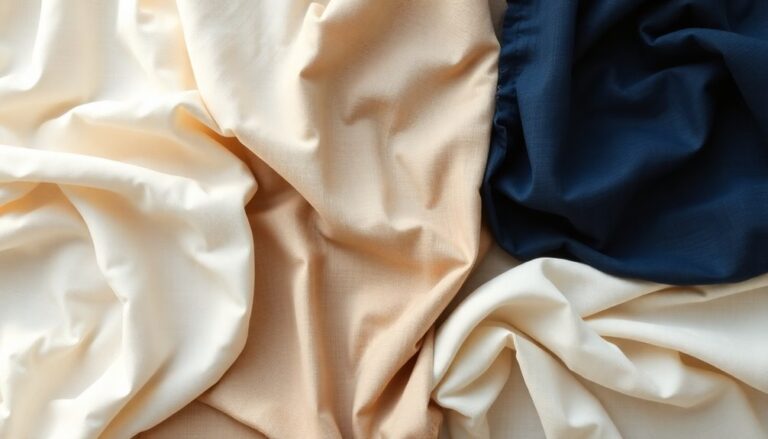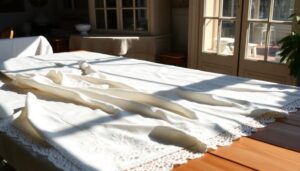The ultimate guide to washing linen emphasizes careful treatment to maintain its natural beauty and durability. Washing with gentle detergents at cooler temperatures protects linen fibers. Avoid bleach and high agitation to prevent damage. For drying, air drying is preferable, whereas low heat settings are suitable for tumble drying. Proper storage and handling prevent creases and wear. With these tips, preserving the quality of linen becomes easier, and there's plenty more valuable information to explore.
Article Highlights
- Use gentle, natural detergents free from harsh chemicals to effectively clean linen without damaging its fibers.
- Wash linen in cold water (30°C to 40°C) on a gentle cycle to preserve fabric quality and prevent shrinkage.
- Air dry linen in a shaded area with good airflow to maintain integrity and avoid fading from direct sunlight.
- Inspect linen before washing for stains or damage, and treat stains promptly with suitable removers to extend lifespan.
- Store linen folded in a cool, dry place to prevent creases and mildew, and refresh with steaming instead of ironing.
Understanding Linen Fabric

Linen fabric, known for its natural elegance and breathability, has been cherished for centuries. Its unique linen characteristics include a crisp texture, moisture-wicking properties, and durability, making it a popular choice for clothing and home textiles alike. Linen comes in various types, such as pure linen, which is made from flax fibers, and blends that combine linen with other materials like cotton or polyester. Each type offers distinct benefits; pure linen is highly breathable and ideal for warm climates, whereas blends may provide improved softness and wrinkle resistance. Comprehending these characteristics and types helps consumers appreciate linen's versatility and care requirements, ensuring they choose the right fabric for their needs.
Choosing the Right Detergent
Selecting the right detergent is crucial for maintaining the beauty and longevity of linen fabrics. Regarding washing linen, choosing a gentle yet effective detergent can make all the difference. Natural detergents are often preferred as they're free from harsh chemicals that can damage fibers. Enzyme-based cleaners can likewise be beneficial, helping to break down stains without compromising the fabric's integrity.
Here are some tips for choosing the right detergent:
- Look for biodegradable, natural detergents to protect the environment.
- Choose enzyme-based cleaners for effective stain removal.
- Avoid fabric softeners, which can leave residues that diminish linen's natural breathability.
Preparing Your Linen for Washing

Before tossing linen into the washing machine, it's vital to prepare it properly to guarantee the best results. A thorough pre-wash inspection is fundamental. This involves checking for any stains, tears, or loose threads that could worsen during the wash. If stains are found, treating them swiftly with a suitable stain remover will help maintain the fabric's integrity. Moreover, it's wise to read the fabric care label for specific washing instructions, as different types of linen may require varied approaches. Sorting by color can prevent dye transfer, ensuring that whites stay bright. By investing time in this preparation, one can improve the longevity and appearance of linen, making every wash a successful one.
Ideal Washing Temperature and Settings
After ensuring linen is ready for washing, choosing the right temperature and settings becomes important for maintaining its quality. The ideal washing temperatures for linen typically range from 30°C to 40°C (86°F to 104°F). Using cooler water helps preserve the fabric's fibers and colors. Regarding washing machine settings, opting for a gentle cycle is essential to avoid damage.
Here are some helpful tips for washing linen:
- Use cold or lukewarm water to prevent shrinkage.
- Select a gentle cycle to protect the fabric.
- Avoid bleach to maintain the integrity of the linen.
Drying Methods for Linen

When it pertains to drying linen, there are several effective methods to take into account. Air drying can preserve the fabric's integrity, whereas tumble drying offers convenience for those pressed for time. Moreover, knowing how to iron linen after drying guarantees a polished finish that improves its appearance.
Air Drying Techniques
Air drying linen is a gentle and effective way to preserve its natural fibers and maintain its quality. By using natural methods, one can guarantee the longevity of their linen items as well as reducing environmental impact. Here are some helpful air drying techniques:
- Choose the Right Spot: Find a shaded area with good airflow to prevent sun damage and fading.
- Use a Clothesline or Hangers: Hang linen items flat or on hangers to help maintain their shape and avoid creases.
- Avoid Overcrowding: Space items apart to allow for even drying and prevent musty odors.
Tumble Drying Tips
For those who prefer a quicker drying method, tumble drying can be a practical option for linen. To maintain the fabric's quality, it's important to use the right tumble dryer settings. A low to medium heat setting is recommended, as high temperatures can cause linen to shrink or become damaged. Furthermore, adding dryer balls can help to separate the linen, allowing for better airflow and faster drying times. It's prudent to remove the linen while it's still slightly damp to minimize wrinkles and facilitate easier folding. Always check the care label for specific guidelines, as proper linen care guarantees longevity and keeps it looking fresh. With these tips, tumble drying can be both efficient and gentle on linen.
Ironing After Drying
One of the essential steps in caring for linen is ironing after drying, as it helps restore the fabric's smooth appearance. Proper ironing techniques can make a significant difference in maintaining linen's quality. When tackling this task, it's important to keep a few things in mind:
- Use a medium to high heat setting customized for linen fabric care.
- Iron when the fabric is slightly damp to ease out wrinkles more effectively.
- Always iron on the reverse side to protect the surface.
Ironing and Storing Linen
In relation to ironing and storing linen, maintaining its quality is essential. Proper ironing techniques can help linens achieve that crisp, polished look. It’s best to use a steam iron on a medium setting, as high heat can damage the fibers. Ironing when the fabric is slightly damp can additionally make the process easier and more effective. Steaming linens properly is another effective way to remove wrinkles without applying direct heat, which can be gentler on delicate fabrics. When storing linens, ensure they are completely dry to prevent mildew and keep them in a cool, dry place. Folding them neatly or hanging them can help maintain their smooth appearance and extend their lifespan.
When it comes to linen storage, verify it's clean and completely dry to prevent mildew. Ideally, store linens in a cool, dark place, using breathable cotton bags or pillowcases to protect them from dust. Avoid plastic containers, as they can trap moisture. By following these guidelines, one can keep their linens looking fresh and prolong their lifespan.
Dealing With Stains on Linen
In the realm of linen, stains can be a common concern. Knowing how to identify typical stains and having effective removal techniques on hand can make all the difference. With the right approach, anyone can keep their linen looking fresh and clean.
Common Linen Stains
Linen, as it is elegant and breathable, is prone to a variety of stains that can be challenging to remove. Comprehending these common stains can help in addressing them effectively. Here are a few stains often encountered on linen:
- Wine stains: These can be particularly tricky owing to their deep color and tendency to set quickly.
- Oil stains: Whether from cooking or body products, oil can leave a greasy mark that's hard to eliminate.
- Food stains: Spills from sauces or fruits can vary in difficulty depending on their composition.
Recognizing these stains is the first step toward effective treatment. The right approach can make a significant difference in maintaining the beauty and longevity of linen fabrics.
Effective Stain Removal Techniques
Effective stain removal on linen requires a strategic approach customized to the type of stain. Different stain types demand specific removal products for ideal results. For instance, oil-based stains often respond well to cornstarch, whereas fruit juice stains might be best treated with cold water.
| Stain Type | Recommended Removal Product | Treatment Method |
|---|---|---|
| Oil | Cornstarch | Blot, then sprinkle |
| Red Wine | Salt | Blot, sprinkle & rinse |
| Ink | Rubbing Alcohol | Dab, then rinse |
| Grass | Vinegar | Soak, then wash |
Maintaining the Quality of Linen Over Time
To guarantee linen retains its quality over time, it is vital to adopt proper care techniques. Comprehending linen longevity tips and fabric care necessities can make a significant difference. Here are some key practices to keep in mind:
- Wash with care: Use cold water and a gentle detergent to prevent wear and fading.
- Avoid bleach: It can weaken the fibers and alter the fabric's natural color.
- Air dry whenever possible: This helps maintain texture and shape during avoiding heat damage from dryers.
Frequently Asked Questions
Can I Wash Linen With Other Fabrics?
Regarding washing linen, it's important to take into account fabric compatibility. Although some people might mix linen with other fabrics, it's typically best to wash it separately or with similar materials. Linen care requires gentle handling, and combining it with heavier fabrics could lead to wear and tear. By ensuring compatibility, one can maintain linen's quality and longevity, allowing it to remain soft and beautiful for years to come.
How Often Should I Wash My Linen Items?
In the domain of fabric care, linen's delicate charm demands attention. For peak linen care, washing frequency depends on usage; typically, every two to three weeks is ideal. Nevertheless, if it's frequently used or soiled, more regular washes may be necessary. This guarantees the fabric retains its breathability and softness. In the end, balancing care with practicality will keep linen looking fresh, like a summer breeze dancing through open windows.
Is It Safe to Bleach Linen Fabrics?
In relation to bleaching linen fabrics, it's important to take into account linen's colorfastness. Some bleaching techniques might damage the fibers or alter the color. If someone decides to bleach, they should use a mild solution and test it on a small area first. Typically, it's safer to avoid bleach altogether, as it can lead to deterioration over time. Instead, opting for gentler cleaning methods is recommended for maintaining linen's quality and appearance.
Can I Use Fabric Softener on Linen?
In terms of linen care, the question of using fabric softener lingers. Although some might think it's harmless, the truth is a bit more complex. Fabric softeners can leave a residue, diminishing linen's natural breathability and moisture-wicking properties. Instead, one should consider softener alternatives like vinegar or baking soda, which can maintain that sought-after softness without compromising the fabric's integrity. In the end, it's about preserving the unique qualities of linen.
What Should I Do if My Linen Shrinks?
If linen shrinks, it can be frustrating, but there are steps to manage it. First, they should avoid hot water and high heat when washing and drying, as this can lead to shrinkage. For proper linen care, using cold water and air drying helps with shrink prevention. If shrinkage occurs, gently stretching the fabric during dampness can help restore its shape. Regularly following these practices can keep linen looking its best.













